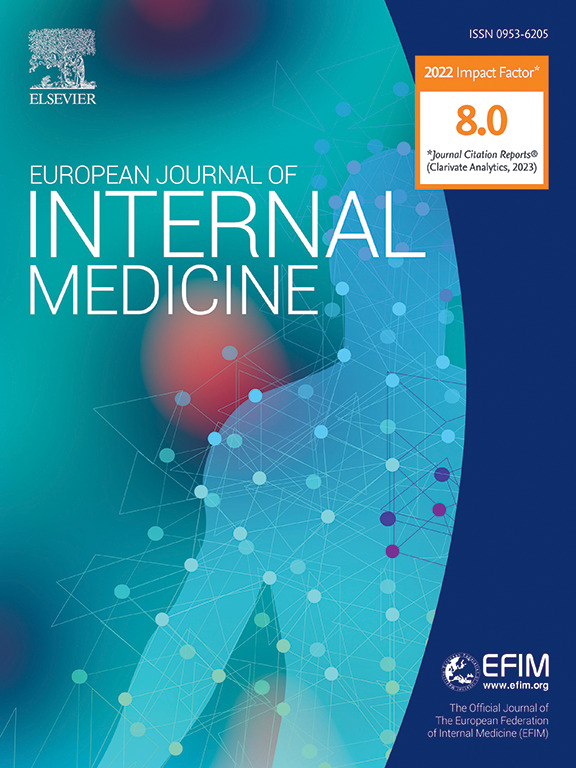心脏磁共振上的原生骨骼肌 T1 时间:预测射血分数保留型心力衰竭患者的预后。
IF 5.9
2区 医学
Q1 MEDICINE, GENERAL & INTERNAL
引用次数: 0
摘要
背景:射血分数保留型心力衰竭(HFpEF)与心力衰竭(HF)住院和死亡有关。目的:我们的研究旨在通过心脏磁共振成像(CMR)上的骨骼肌T1-时间测量骨骼肌组成,探讨骨骼肌组成与不良预后之间的关系:方法:我们在一个前瞻性队列中测量了HFpEF患者标准CMR图像上背部肌肉的骨骼肌T1-时间。采用 Cox 回归模型检验骨骼肌 T1 时间与不良预后(定义为心房颤动住院和/或心血管死亡)的相关性:研究共纳入 101 名患者(平均年龄为 72±7 岁,71% 为女性)。骨骼肌 T1 时间的中位数为 842 毫秒(IQR 806-881 毫秒)。在单变量分析中,高肌肉 T1 时间与不良预后相关(每增加 100 毫秒,HR=1.96 [95 % CI, 1.31-2.94]; p=0.001)。在对年龄、性别、体重指数、左室和右室射血分数、N末端脑钠肽和心肌原生T1-时间进行调整后,原生骨骼肌T1-时间仍是不良预后的独立预测因子(每增加100毫秒,HR=1.94 [95 % CI, 1.24-3.03]; p=0.004):简短摘要:骨骼肌异常在射血分数保留型心力衰竭(HFpEF)患者中很常见。本研究通过标准心脏磁共振成像中背部肌肉的原生骨骼肌T1-时间量化骨骼肌组成,评估骨骼肌组成与不良预后(定义为心衰住院和/或心血管死亡)的关系。在一个由 101 名高频心衰患者组成的前瞻性队列中,我们发现原生骨骼肌 T1 时间高与不良预后风险增加有关。这些发现表明,原生骨骼肌T1-时间可作为改善风险预测的标志物。本文章由计算机程序翻译,如有差异,请以英文原文为准。

Native skeletal muscle T1-time on cardiac magnetic resonance: A predictor of outcome in patients with heart failure with preserved ejection fraction
Background
Heart failure with preserved ejection fraction (HFpEF) is associated with heart failure (HF) hospitalizations and death. Previous studies have shown that altered muscle composition is associated with higher risk of adverse outcome in HFpEF patients.
Aim
The purpose of our study was to investigate the association between skeletal muscle composition, as measured by skeletal muscle T1-times on cardiac magnetic resonance (CMR) imaging, and adverse outcome.
Methods
We measured skeletal muscle T1-times of the back muscles on standard CMR images in a prospective cohort of HFpEF patients. Cox regression models were used to test the association of skeletal muscle T1-times and adverse outcome defined as hospitalization for HF and/or cardiovascular death.
Results
We included 101 patients (mean age 72±7 years, 71 % female) in our study. The median skeletal muscle T1-times were 842 ms (IQR 806–881 ms). In univariate analysis high muscle T1-time was associated with adverse outcome (HR=1.96 [95 % CI, 1.31–2.94] per every 100 ms increase; p=.001). After adjustment for age, sex, body mass index, left- and right ventricular ejection fraction, N-terminal pro-brain natriuretic peptide and myocardial native T1-times, native skeletal muscle T1-time remained an independent predictor for adverse outcome (HR=1.94 [95 % CI, 1.24–3.03] per every 100 ms increase; p=.004).
Conclusion
In patients with HFpEF, high skeletal muscle T1-times on standard CMR scans are associated with higher rates of HF hospitalizations and cardiovascular death.
Condensed abstract: Skeletal muscle abnormalities are common in patients with heart failure with preserved ejection fraction (HFpEF). The present study evaluates skeletal muscle composition, as quantified by native skeletal muscle T1-times of the back muscles on standard cardiac magnetic resonance imaging, and assessed the association with adverse outcome, defined as hospitalization for heart failure and/or cardiovascular death. In a prospective cohort of 101 patients with HFpEF, we found that high native skeletal muscle T1-times are associated with an increased risk for adverse outcome. These findings suggest that native skeletal muscle T1-time may serve as marker for improved risk prediction.
求助全文
通过发布文献求助,成功后即可免费获取论文全文。
去求助
来源期刊
CiteScore
9.60
自引率
6.20%
发文量
364
审稿时长
20 days
期刊介绍:
The European Journal of Internal Medicine serves as the official journal of the European Federation of Internal Medicine and is the primary scientific reference for European academic and non-academic internists. It is dedicated to advancing science and practice in internal medicine across Europe. The journal publishes original articles, editorials, reviews, internal medicine flashcards, and other relevant information in the field. Both translational medicine and clinical studies are emphasized. EJIM aspires to be a leading platform for excellent clinical studies, with a focus on enhancing the quality of healthcare in European hospitals.

 求助内容:
求助内容: 应助结果提醒方式:
应助结果提醒方式:


